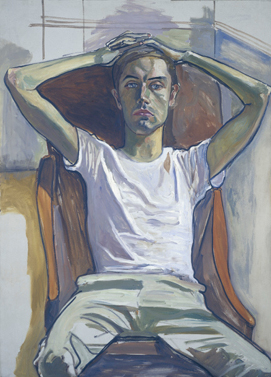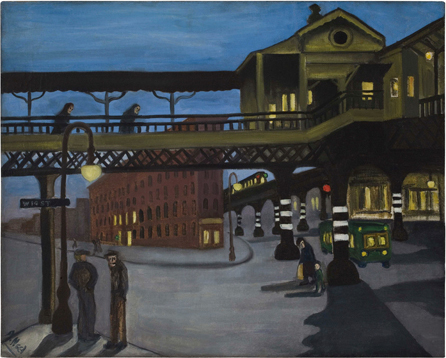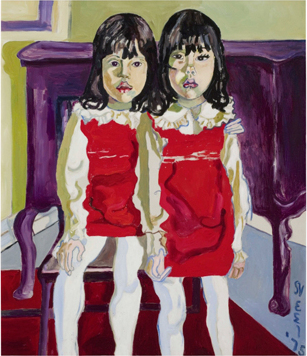
Alice Neel, Hartley, 1965 © Estate of Alice Neel/National gallery of Art, Washington, D.C., gift of Arthur M. Bullowa, in Honor of the 50th Anniversary of the National Gallery of Art
The exhibition’s nine sections
Allegory
Allegories, pictures that mean something other than that which they depict, were rare in early modernism, but by the 1910s, artists such as Max Beckman, Gorge Grosz and Otto Dix began creating satirical allegories on social injustices. Meanwhile, de Chirico was painting his metaphysical works, in which he combined objects to express something that lay beyond the physical realm. The surrealists adopted this individualistic form of allegory to portray the unconscious, while the
Mexican artists Diego Rivera and José Clemente Orozco used alle-gory to point at the wrongs and inequality in society.
Like these artists, Alice Neel was a leftist, but her allegories were not critical of society; instead, they express strong personal experiences and feelings. In the painting Symbols (Doll and Apple) she processes the pain after her husband left her, taking their daughter with him to Havana. On a white table top lies a naked doll, surrounded by Christian symbols, suggesting the story of God commanding Abraham to sacrifice his only son, Isaac. The apples on the table can be interpreted as religious symbols of the Fall of Man, while also referring to Cézanne’s still-life.
Neel usually never explained her allegories, but the portrait of Kenneth Fearing from 1935 is an exception. Fearing wrote about the suffering during the Depression, and the painting is inhabited by figures from his poems. The light bulb in the upper edge is both a reference to his habit of working at night, and a symbol of enlightenment and modernism. In the background is Sixth Avenue El, which was near Fearing’s home. The baby denotes his recent fatherhood, while a skeleton wrings blood from his heart to symbolise his compassion for mankind
The Essential Portrait
Alice Neel’s portraits can be divided into three stylistic periods that occasionally overlap. Her early works from the 1920s and early 30s include distinctive symbols that reveal influences from surrealism and Latin American art, while her works from the late 1950s until her death are occupied with the figurative relationships between the pictorial elements, in a striving to express the psychological dimension of her subjects.
The essential portraits, with a strong focus on the model and the carefully worked yet neutral backgrounds that sets them apart from both the earlier and the later works, were painted in between these two periods. Here, she eschews the occasionally surrealist elements of the early paintings, but does not yet give herself the liberty found in her later psychological portraits. Of all her paintings, these essential portraits, with their strong focus on the model are the part of her oeuvre most strongly connected to traditional portrait painting.
Neel’s portrait of the writer Max White is typical of this straight-forward style. By depicting White face-on, against a neutral, light and dark grey background, Neel draws the viewer’s attention to White’s face, with its painstakingly chiselled features and pene-trating gaze. Neither hands, shoulders nor eyes are aligned, thus increasing the tension in the picture.
The Psychological Portrait
Alice Neel saw herself as a ”collector of souls”; she was a psychotherapist and the feelings and experiences of her models are clearly visible in her paintings. Only rarely did Neel base her work on photographs. She preferred live models and the intimacy this entailed. The German artist Gerhard Richter is of a different opinion with regard to portrait painting, claiming that the artist need neither see nor know the model, the soul does not have to shine through in the portrait. It is the likeness that is important to an artist such as Richter.
Neel takes the opposite position; she could distort, reduce, enlarge, colour the model’s skin red and green, twist limbs. Realistic imagery was not important – it is the soul of the model she wants to portray. Who is this person, really? The true image, not the correct likeness, was the essential subject. Neel admired Pablo Picasso and said that he showed “the human race torn to pieces” in his cubist portraits from 1910–1912. In a similar way, Neel, conjures up a personality through what may even seem like unnatural means.
The posing, the interplay between artist and model, demonstrates Neel’s dedication to the rules and traditions of classical portrait painting. The presence and exchange gave Neel the extra information she needed in her work. Time was essential to Neel. She reproduced gestures and behaviours that were specific of a certain period. The individuals were conveyors of history, and the sometimes unfinished impression of her images lends a feeling of movement and creation
to the whole. The self unfolds as we watch.
Portraits From Memory
Alice Neel preferred painting from live models and only rarely used photographs instead, but she also painted many pictures from memory, including portraits of people she had met and memories of events that had been important to her. Neel was influenced by the portrait artist Robert Henri’s ideas on the importance of memory to the artist. In his book The Art Spirit, which Neel owned and recommended to other, younger painters, Henri emphasises that it is essential for artists to improve their memory. By remembering an image, the artist could create a picture, says Henri, not only of the subject, but of its entire essence.
In Childbirth Neel recalls the image of Goldie Goldwasser in labour. As though to alleviate the pain, Goldwasser raises her arms so that they frame her face, where the vacant gaze, the black rings around the eyes and mouth, depicted as a black hole, reflect the immense exertion. According to Neel, the pain is concentrated to such a specific area that Goldwasser forgets that she has shoulders, and the focus of the painting is instead on the bulging breasts and the torso. Goldwasser and Neel were in the same maternity ward, and while the painting shows her friend’s pain, it also expresses Neel’s own memories of giving birth to her son.
Neel never painted her father while he was alive, but a few days after he died in 1946, she portrayed him the way she remembered him when he was lying in his coffin, pale and lifeless. It may seem macabre, but to Neel this painting, Dead Father relates to the tradition of votive paintings and to contemporary Latin American art, and the portrait was a tribute to her dearly beloved parent.
Cityscapes
Although Alice Neel is known mainly for for her portraits, she also painted landscapes, still lifes and cityscapes. She lived in New York for most of her life, and her city motifs can roughly be divided into three categories: the Greenwich Village years, the Spanish Harlem period, and Neel’s final years on Upper West Side. While the paintings from Greenwich Village often feature street life, the ones fromSpanish Harlem convey a sense of isolation and imprisonment. In the painting Fire Escape the emergency exit on the exterior of the building looks more like a cage than the escape route it is intended to be. The ensuing paintings from Upper West Side are dee per and brighter.
Many of the street scenes originate in the 1930s, when she was enrolled in the Public Works of Art Project (PWAP) and later in the easel division at the Works Progress Administration (WPA). The WPA provided schools, libraries and public buildings with art, and the enrolled artists were to deliver a painting every six weeks, paying tribute to different aspects of Amer-ican life, de-pending on where they were to be hung. Nudes and portraits that did not depict historic figures were not allowed.
Neel’s cityscapes portray the time in which they were painted. Unlike her portaits, which brought out the humanity of the portrayed person, Neel’s painting of Ninth Avenue El shows how the city robbed the poor inhabitants of their identity. With bowed heads and dark clothes, they steal along the streets. Their faces look gauntly cranial. The depression and poverty of the time is obvious. Other city paintings, such as Snow on Cornelia Street, give a more intimate and poetic picture of New York. The large scale of the city is outshone in Neel’s portrayal of the everyday scenes seen from her home.
Nudes
Women art students were often excluded from the life drawing classes since it was considered improper for them to draw nude models. No exception was made for Alice Neel, and during her early studies at the Philadelphia School of Design for Women she was only allowed to draw clothed bodies and plaster casts. After six months, however, she was permitted to attend the croquis class.
In the late 1920s, Neel painted nudes, but her depictions are far from the ideal female body; instead, she was striving to capture a true image of what she saw, inspired by artists such as Paul Cézanne and Otto Dix. Her painting of fellow artist Ethel Ashton is both raw and revealing. Neel has a dominant position and Ashton is looking up at her with a pained expression in her eyes, as though embarrassed to show herself in the nude. The body fills the pictorial space, is pressed out in every direction so that the edges of the canvas cut through her head and crop off her arms and legs.
Joe Gould was a failed writer who was unlucky in love and bad at handling money. From a secure upper-class background in Boston, he moved to Greenwich Village, where his social decline eventually reduced him to begging in the streets. Neel portrayed Gould from several angles and made numerous studies of his penis in varying states. In this way, she plays visually with the phallus as a symbol of power. By making the three penises resemble udders, she feminises them and undermines their masculinity, making him appear an absurd character. The three portraits of Gould can also be seen as a farcical travesty on the three graces, with three pot-bellied middle-aged men in the place of the mythical beauties of the fine arts.
In the late 1960s, attitudes to nudity had changed, but a woman artist who painted nude women risked being perceived as reactionary by the growing women’s movement. Few women artists painted pictures of pregnancy, but Neel now produced several portraits of expecting women, as yet another normal body type, wholly in keeping with the spirit of women’s lib.
Parents and Children
A series of paintings on the mother and child theme demonstrates Alice Neel’s particular fascination for the subject. And by opting not to paint celebrities and instead portray ordinary people leading impoverished lives, she exalted childrearing to a laudable activity. Her interest in the feminist movement and women’s rights is plainly manifested.
Most of Neel’s paintings of mothers and children are devoid of any specific interest in portraying everyday family life, however. Instead, they focus on the interaction, or lack of it, between parent and child. The terse paintings are reminiscent of Vincent van Gogh’s late portraits, with their sharp contours and large colour fields.
Neel concentrated on motherhood as a social and physical phenomenon. Instead of producing any general tribute to female fecundity and family life, however, several of her paintings are frightening and morose. Even the paintings of her own family appear slightly disturbing. Mother and daughter cling to one another, in plain, un-adorned settings. One of the few portraits of a father and child is Don Perlis and Jonathan. The son, Jonathan, who has cerebral palsy, is shown trying in vain to get his father’s attention, while Perlis stares vacantly into space. The child’s white, almost translucent skin gives a ghostly impression.
The Detached Gaze
Neel painted numerous portraits of her children and grandchildren. In these paintings, she restrained her predilection for the grotesque and instead focused with great compassion on the children’s feelings of insecurity, rebellion and fear, as though experiencing them herself.
The portrait of Isabetta was painted on one of the rare occasions when Neel got to meet her daughter. By depicting Isabetta with her hands on her hips and a defiant look, clearly signalling that theirs is not a close relationship, Neel candidly reveals the uncomfortable predicament of them both. In Olivia in Red Hat, painted forty years later, Neel por-trayed her first grandchild. Here, the pose is repeated, but now the subject is dressed in a bikini. Olivia becomes Isabetta’s double; her red hat billows like Isabetta’s hair, and she also has her hands on her hips. The lack of nudity is significant, since Isabetta’s nakedness represented defiance, while the image of Olivia’s scrawny, bony body is Neel’s portrayal of youthful awkwardness.
Neel painted the portrait of her grandson Andrew from memory. This is her only portrait of a solitary baby. Andrew is in robust good health and looks like a small bundle of energy. He is oblivious to his grandmother’s gaze and appears instead to be drawn to something outside the picture, presumably his mother, Ginny. The perspective is that of a nappy-changing adult – a theme that relates to the everyday life and chores of women.
Old age
Rembrandt is one of the few artists who painted old people with empathy and discernment. Throughout his career, he painted old people from all walks of life. It was not until after her father’s death in 1946 that Alice Neel began painting old people. During the latter half of her career, Alice Neel painted many portraits of older people. In the same way that her psychological portraits captured the model’s soul, she managed to capture the signs of ageing. Last Sickness is a forthright example of how Neel applied both empathy and objectivity in the same work. It shows Neel’s mother, who was dying of cancer, with hollow cheeks, tousled, white hair and jaundiced skin. Half of her face is obscured by shadow, to signify that death is approaching.
Alice Neel did not avoid the theme of death, she looked old age in the eye without sentimentality or hope of peace, and once described death as “a dreadful black hole, an everlasting void, a nothing”. When she was 80, Neel painted her first self-portrait. It is a candid painting. Naked, with sagging breasts, she sits, wearing glasses so she can see herself better and more truthfully. Like Rembrandt’s self-portraits it is brutally honest. Alice Neel’s respect for age is revealed in this honesty, the same honesty that suffuses her entire oeuvre.


